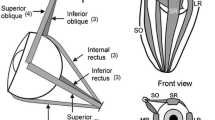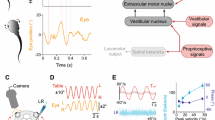Summary
-
1.
There are three distinct kinds of coordinated eye-body movements in the African cichlid fish,Haplochromis burtoni, as revealed by cinematographic analysis: a) eye movements without coordinated body movements (voluntary saccades); b) nystagmus consisting of compensatory eye movements during turning of the body and a reset saccade movement of the eyes; c) fast body turns executed without corresponding eye movements.
-
2.
During voluntary scanning eye movements the eyes usually move in temporal synchrony and often the result is a decreased angle between the eyes (increased convergence of the eyes).
-
3.
Compensatory eye movements produce successive fixation of the gaze direction during a slow rotation of the body which serve to maintain the angular orientation of the eyes in space. No systematic change in convergence is associated with these turns.
-
4.
Fast body turns are very rapid body turns without compensatory eye movements which occur almost exclusively during social interactions.
-
5.
When the animals are freely swimming, these three types of eye-body movements occur in all possible sequences.
Similar content being viewed by others
Abbreviations
- BO :
-
body
- CF :
-
compensation factor
- LE :
-
left eye
- RE :
-
right eye
References
Cohen B (1974) The vestibulo-ocular reflex arc. In: Kornhuber HH (ed) Vestibular system, Part 1, Basic mechanisms (Handbook of sensory physiology, vol VI/1. Springer, Berlin Heidelberg New York, pp 477–540)
Dodge R (1903) Five types of eye movements in the horizontal meridian plane of the field of regard. Am J Physiol 8:307
Easter SS Jr (1971) Spontaneous eye movements in restrained goldfish. Vision Res 11:333–342
Easter SS Jr, Johns PR, Heckenlively D (1974) Horizontal compensatory eye movements in goldfish (Carassius auratus). I. The normal animal. J Comp Physiol 92:23–35
Easter SS Jr, Johns PR, Baumann LR (1977) Growth of the goldfish eye. I. Optics. Vision Res 17:469–477
Fernald RD (1975) Fast body turns in a cichlid fish. Nature 258:228–229
Fernald RD (1977) Quantitative behavioral observations ofHaplochromis burtoni under semi-natural conditions. Anim Behav 25:643–653
Fernald RD (1982) Retinal projections in the African cichlid fish,Haplochromis burtoni. J Comp Neurol 206:379–389
Fernald RD (1983) Neural basis of visual pattern recognition in fish. In: Ewert RP, Capranica RR, Ingle DJ (eds) Advances in vertebrate neuroethology. Plenum, New York London, pp 569–580
Fernald RD (1984) Vision and behavior in an African cichlid fish. Am Sci 72:58–65
Fernald RD, Hirata NR (1977a) Field study ofHaplochromis burtoni: Quantitative behavioral observations. Anim Behav 25:964–975
Fernald RD, Hirata NR (1977b) Field study ofHaplochromis burtoni: Habitats and co-habitants. Environmental Biol 2:299–308
Fernald RD, Wright SE (1983) Maintenance of optical quality during crystalline lens growth. Nature 301:618–620
Fernald RD, Wright SE (1984a) Growth of the visual system in the African cichlid fish,Haplochromis burtoni: Optics. Vision Res (In press)
Fernald RD, Wright SE (1984b) Growth of the visual system in the African cichlid fishHaplochromis burtoni: Accommodation. Vision Res (In press)
Hirata NR, Fernald RD (1975) Non-intentional sound production in the African cichlid fish,Haplochromis burtoni. Experientia 31:299–301
Hoist E von (1950a) Die Arbeitsweise des Statolithenapparates bei Fischen. Z Vergl Physiol 32:60–120
Holst E von (1950b) Quantitative Messung von Stimmungen im Verhalten der Fische. Symp Soc Exp Biol 4:143–172
Hunter J (1786) The use of the oblique muscles. In: Observations on certain parts of the animal oeconomy. London, pp 209–212
Trevarthen C (1968) Vision in fish: The origins of the visual frame for action in vertebrates. In: The central nervous system and fish behavior. Ingle D (ed) University of Chicago, Chicago, pp 61–94
Walls GL (1967) The vertebrate eye and its adaptive radiation. Hafner, New York
Walls GL (1962) The evolutionary history of eye movements. Vision Res 2:69–80
Author information
Authors and Affiliations
Rights and permissions
About this article
Cite this article
Fernald, R.D. Eye movements in the African cichlid fish,Haplochromis burtoni . J. Comp. Physiol. 156, 199–208 (1985). https://doi.org/10.1007/BF00610862
Accepted:
Issue Date:
DOI: https://doi.org/10.1007/BF00610862




